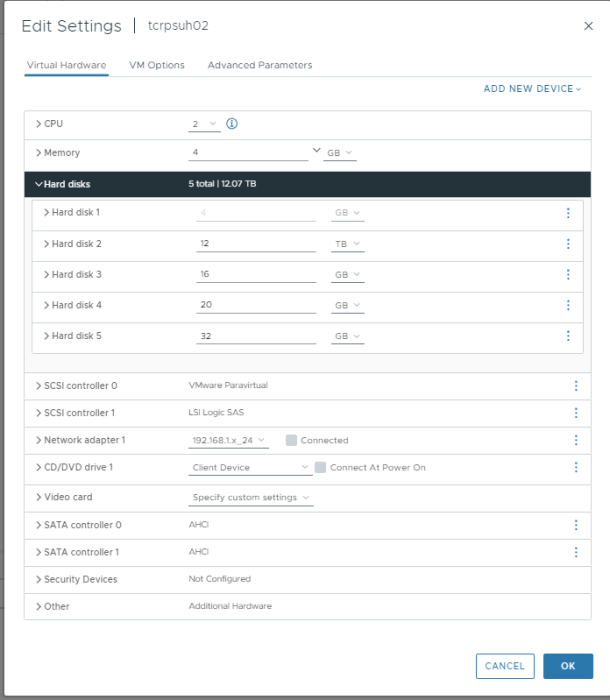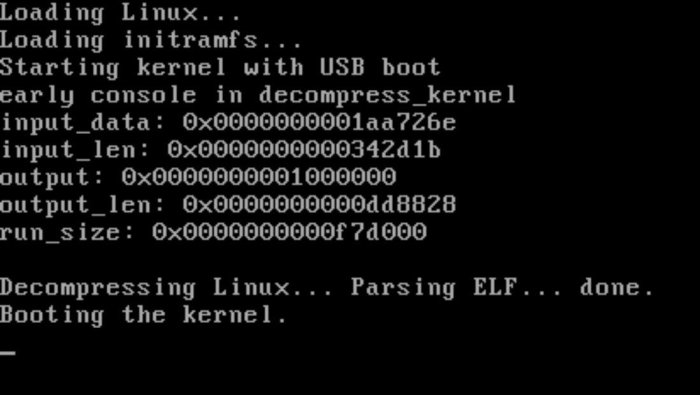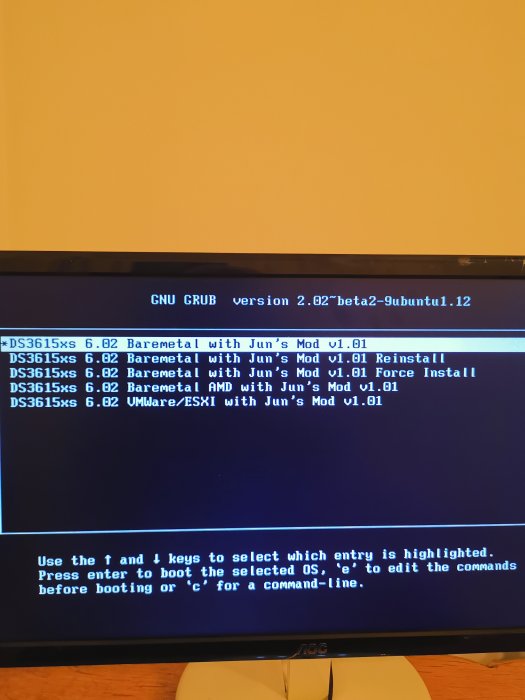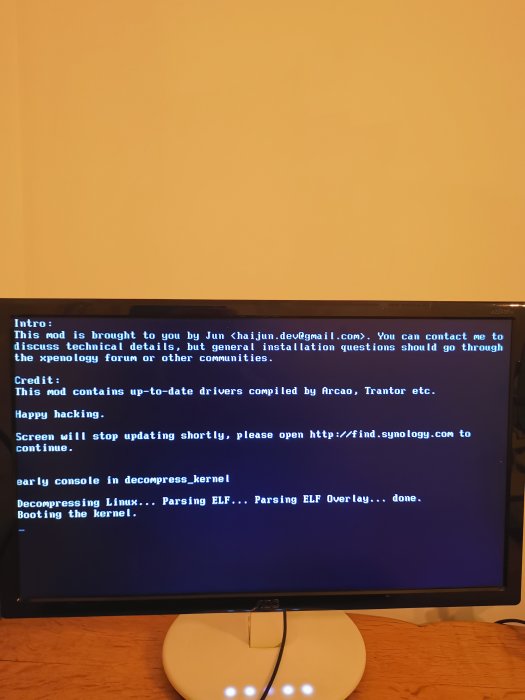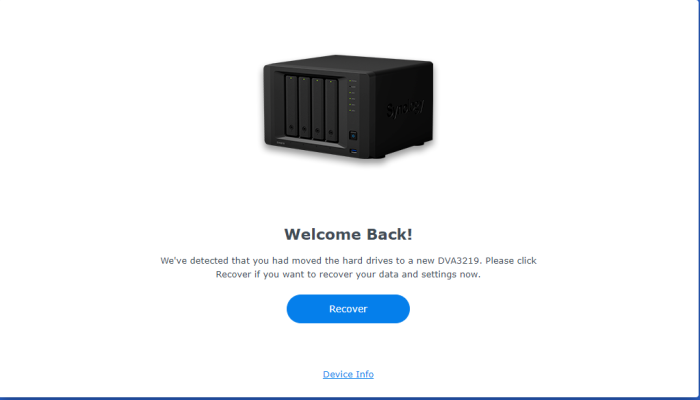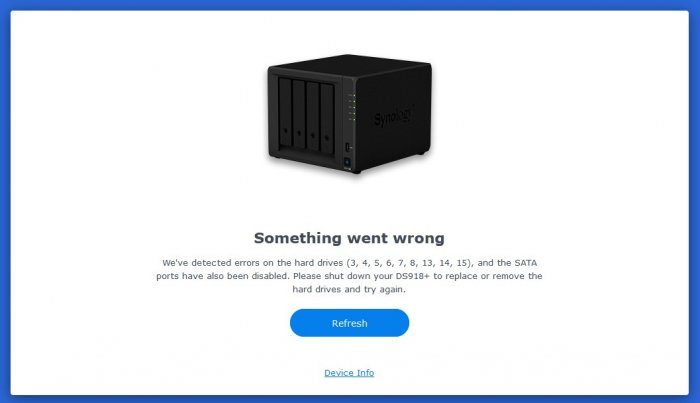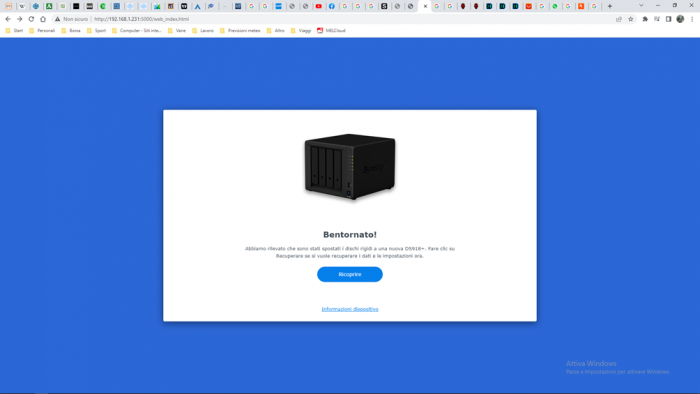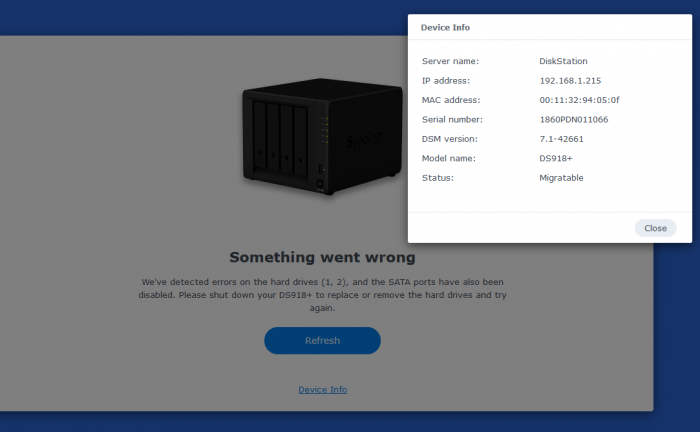Search the Community
Showing results for 'detected that the hard drives'.
-
This project started about two weeks ago at the suggestion of @wjz304 . A guide that can be processed with Jun's loader in DSM 6 already exists as shown below. This method requires a lot of manual work through MS Windows. Redpil plans to create a simpler automatic script as a menu function. https://github.com/PeterSuh-Q3/tinycore-redpill/blob/main/menu_m.sh#L1688 The part where tcrp-mshell is slightly different from rr is tcrp, as its name suggests, is a redpill loader that uses tinycore Linux, so it includes one more kernel. The kernels used by rr and tcrp are as follows. 1. rr kernel (tcrp is friend kernel) 2. dsm kernel (same for tcrp) 3. tc kernel (tcrp only) rr contains all the functions that the tc kernel and friend kernel must perform in the rr kernel. This is why the menu starts directly with ./menu.sh in the rr kernel. The reason I explained these kernels is Ultimately, these kernel files (2 per kernel) must be ported to the hard drive. The existing DSM 6 Jun's loader had a kernel size of only 50M, so 100M of spare space at the end of the first hard drive was sufficient. However, Red Pill is equipped with various kernels, and the files for each kernel are close to 100M. 1. tc kernel (20M, mydata.tgz backup file is variable) 2. Friend kernel (61M fixed size) 3. dsm kernel (based on ds3622xs+ 7.2.1-69057, 82M initrd-dsm is variable [including driver modules and addons for each model]) The loader on the original USB stick is all in the 3rd partition with a lot of free space. It is impossible to store all of this in 100M on one hard drive. Give up less and only take items 2 and 3 and use 2 hard drives. Two hard drives created as Basic or JBOD type are required. Assuming that the structure of each hard drive on which the storage pool is created is of the above two types, It consists of system partition 8G + 2G and data partition (the entire remaining area). I thought there was only about 100M space behind the data partition. If you look closely, there is about 128M more free space between the system partition and data partition. You will see that the Start / End sectors are not connected and are empty. In the meantime, create an extended partition, sd#4, and create additional logical partitions where the bootloader partitions should exist. This capture shows bootloader partitions 1, 2, and 3 split into two hard drives. The first partition has 98M space. Contains the friend kernel from number 2 above. Because the location of the kernel changed, modifications were made to a separate grub.cfg. The existing boot loader searches for (hd0, msdos1) and includes the part where grub is set to boot. Use grub-install to readjust it to point to (hd0,msdos5) = /dev/sd#5. Activate /dev/sd#5, which corresponds to the first partition of the boot loader, to Active so that the hard drive can boot grub on its own. The second partition does not require a lot of space, but The important part contains rd.gz extracted from the original dsm pat file. When an update for SmallFixVersion is detected, it automatically assists in update processing through Ramdisk automatic patching. Currently, DSM 7.2.1-69057 is a file required to automatically update U0 to U4. In the 3rd partition The DSM kernel for each model is included. This is a kernel file that keeps changing and being regenerated every time you rebuild the loader. The intermediate file custom.gz (contains rd.gz and the driver) is also included. Because the size is not trivial, the final result, initrd-dsm, contains almost the same content. We have found a way to exclude it and have recently reflected it in the friend kernel version upgrade in advance. In the case of rr, the size of custom.gz and initrd-dsm contains too many modules (e.g. wifi module, etc.) compared to tcrp. As it is, only 2 hard drives are insufficient. I am not sure if wjz304 is well aware of this and is adjusting the kernel size related to this. With this preparation in place, you can boot with the bootloader implanted using only two BASIC type hard drives. For this purpose, remove the original bootloader, USB or SATA DOM bootloader. Up to this point, I have implemented the bootloader script and completed the first test. Following this topic, I would like to separately explain the problems and solutions I would like to consider.
-
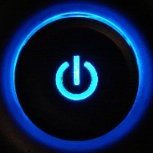
Converting ds1515+ into ds1517+ DSM 7.2
Synology_Service replied to K4L0's topic in Hardware Modding
I'm gonna try to get a formula to do it. Now I happen to be lucky and have many BIOS versions of the DS1515+.Read right off the chips. I use them when restoring corrupted ones. I can say. The bios update when you install DSM it is in the DSM.pat file update. Mainly on the later DSM 7.x Pat files. So Synology is placing the bios update in the pat file. What I am worried about is one thing I tested with the script above. This works perfect on the latest release of DSM 7.2. But I suspect it will brick the system when DSM7.3 comes out. As a rewrite will happen to the bios. Synology has been getting tricky with this. Mainly to support their drive compatibility. So only you can use their drives in the system for the future. On newer models. Not on older units as much. But it still makes changes to the bios when you update past DSM 7.2x or higher. As they are released. Now faking the bios as a DSM 7.3, and doing the pat file as 7.3. The system bricked on my test side. It booted. But the drive array was lost. And all bay lights lit solid. So I had to reinstall the old bios that had DSM 6.2.4. And it came back. ANd now is normal again. The fake DSM7.3 did something weird to the drive array. All bay lights lit up, and no drive detected. So make sure you have a backup of your old bios just in case. The chip is a N25Q064A 3v. Now I was also thinking. Why not keep the old DSM. And just never do anything inside the NAS. But change the app to install in your NAS. Like take a DS1517+ app you might like. And change a few things on it. And it install it on your 1515+. Much to research and try. Also a quick note. When it comes to updating to DSM 7.x.x We never recommend to update past DSM 6.2.4. As you end up losing so much. Photostation gone. To a rinky thing called Photos. Below is a copy and paste of my Reddit post about this topic. Something to read if you have time. ---------------------------------------------------------------------------------------------------- Please note to admins of Xepenology. Let me know if I ever wrote anything wrong her to remove. Will do ASAP. r/Synology_Service: TO UPDATE TO DSM7, OR NOT TO UPDATE. THAT IS THE QUESTION Alot of NAS owners, and even my own customers always debate this one topic, and even ask me about it if it is recommended. You won't believe it. But I always say NO. Don't update your NAS. Lets look at the pro and cons. First the pro's. DSM7 has a all new look. Feature rich, and has the latest updates to bug fixes and security flaws. Its kinda like going from Windows 10 to Windows 11. And that's pretty much where the story ends with DSM7. DSM 6 has all the same features. And also has its own updates. Like the recent update 7 added to DSM6. So you end up with DSM 6.2.4 Update 7. Like Windows that do security updates and feature packs. You're probably wondering why I said don't update? For 1. You can never go back that's for sure. Unless you know how to reprogram the Daughter board on the NAS. eDOM. You are on DSM7 forever. SO some of the bad in updating. DSM7 added some white lists for drives. And makes drive compatibility a issue. It doesn't carry support for WIFI dongle use. Surveillance Station comes with a loss in license counts. Photostation is gone to a rinky dink app called Photos. Doesn't work with the app anymore. The list is endless. And at your loss. Why I say. Never update unless you know you really have to. And need it. Why DSM6 is the best robust OS Synology made. Even though my real favorite is the older DSM 5.2. I personally think that was the best they ever made. During their heyday. It was tops. But 6.2.4 is the overall, all NAS best DSM ever made. Last of the good ones. Alot of owners really need to ask themselves. Do I need this update? Is my NAS doing ok where I am? If there's something in the latest update that applies to you. Then do it. Forget the security flaws. Nobody ever gets hacked in NAS history. Ever saw a post on one? NO!. Hackers want PC's. Not disk stations. Besides. What's to hack on so many of these. Your videos? Or pictures. What good is that stuff to hackers? Hackers want stuff that gets them into your emails and money. Like your PayPal account. Not your movies or pics. These are just Synology's way of getting you to update, so they can slowly migrate you over to the new "get our drives only and apps route" in my opinion. Yea that ever shrinking drive compatibility list. And yes. the future for Synology will be to use their drives only. No 3rd party drives like WD and Seagate. They are working on their own drives now as I write. And now even the current DSM7 omits many drives. So you can't use them like on the older DSM's. Also the apps. A Lot of this started as licensing for apps were expiring from Synology to 3rd party developers. Like surveillance station. Synology didn't want to pay for another license. But on the old DSM. You can still use it. This is just one app affected. There are more. Plus. Updates can be a issue. They are known to crash NAS's if something gets corrupted. I see it alot. Imagine you are sleeping during an automatic update, and or even there. Just to see a blue blinking power light forever. DSM and even app updates are like doing PC bios updates. If just one bit is off, and the checksum is not correct. Its a fail. you now lost your NAS, and anything else it can do. Has to go for service. And if you are out of warranty. Synology won't fix it. Their support centers are only RMA work under warranty. They aren't going to solder a new Bios or Daughter board on your NAS. Nope. Ends up here where we do that kind of work. Board level repairs. Chip changes. Bioses, you name it. So look at where you station is today. Is it doing its job like it always has? Then don't touch was isn't broken. Or decide. Do I really need this update to DSM7 from my old 6.2.4? Most likely not, and like 95% of the NAS owners out there. You don't need it. We also started to see this on the resale side. Where older Synology NAS's selling used. Have gone up alot in price. Even from the ones I sell. Like $400-$600 for a DS1512+. Same price as a 1817+ or newer. I also get many requests for NAS's only on DSM 6.2.4 or earlier. They don't want DSM 7 or higher. If its on DSM7. This kinda hinders sales for these. As only a select group of new comers usually get them. Not die hard Synology fans. No they don't want DSM7 if you truly know your NAS. And use the apps alot. Make sure you turn off automatic updates on your NAS. And take control. Don't let Synology do the update. You decide what needs updating if need be. If its working leave it. Forget the security update crap from Synology in my opinion. 99% chance it doesn't apply to you anyways. Today! I get many that come here who want downgrades. That too is rising. -
TinyCore RedPill Loader Build Support Tool ( M-Shell )
mealan replied to Peter Suh's topic in Software Modding
Just to validate things I made multiple scsi controllers of all different types and another sata controller. sadly none of them appear "green" each hard disk is attached a different controller just to try to get one of them to show up. What's odd is that they show up in the drives as above. but after the mapping and building the loader get the "no drives detected" section -
Rick4 Now ARC loads after build process and it can see hard drive (currently one only). The problem is Synology Web Assistant does not: "No drives detected". I tested two models: DS224+ and DS3617Xs. DS918+ and DS3615xs are not listed when I configured ARC. ARC loader reports: "Please, insert at least one SATA/SCSI disk for system installation ...". Checked one disk and two disks. Both disks are ok. I don't have any problems with them. The point is I successfully run Ubuntu Server on this hardware and it finds all the disks. Do I need make any changes to ARC configuration? And by the way in the very beginning of ARC configuration process there is a question: "Do you need Syno Services"? What is it? Do I need to turn it on?
-
Hello, I am trying to install the DSM on the following computer: Intel Core i5-12400F 4.4GHz Gigabyte B660M DSH3 AX DDR4 Corsair Vengeance LPX DDR4 3200 PC4-25600 16GB 2X8GB CL16 Black Aerocool CS-105 USB 3.0 Black/Red with Window Crucial SSD 1GB 2 SATA 2TB Gigabyte GeForce GTX 970 Gaming G1 WindForce OC 4GB GDDR5 I have tried with the arl, arc and redpill loaders, loading the r8125 module, since my integrated network card is a Realtek 8125BC 2.5GB, the fact is that with all the loaders, when DSM is loaded it crashes, I cannot find the DSM from find.synology.com or from the wizard. It has only worked for me once, with an "arpl" loader that failed yesterday, I put the same loader today and it found it, the installation started, it detected the hard drives and the formatting crashed, after more than half an hour, I reset, I tried those disks again in Windows and I had made 3 partitions, one of 8GB, one of 2GB and the remaining unallocated space. After that successful connection, it has not worked again in any way. You know that it may be due?
-
Hi! Im trying to install DVA3221 on Proxmox, But I always get 2 errors When I run ```./rploader.sh satamap now``` I got - No drives detected When I dont run ```./rploader.sh satamap now``` I got - We've detected errors on the hard drives (7, 8), and the SATA ports have also been disabled. How to setup drives correctly on proxmox?
-
Please help! I was updating my BAREMETAL - Microserver Gen8 that ran DSM 7.0.1 DS3622xs+. I've read the forum and made the following: in DSM 7.0.1 gui I manually updated to 7.2.0 waited 10+ min, it hasn't rebooted but hasn't accessed HDD either so I manually rebooted it (possibly my mistake) loaded onto TCRP (no friend) run the following ./rploader.sh clean ./rploader.sh update now ./rploader.sh fullupgrade now ./rploader.sh build ds3622xsp-7.2.0-64570 withfriend (also run on another attempt w/o friend) exitcheck.sh reboot On the first try I after reboot got Loading Linux error: premature end of file /bzImage-friend. checked the sd-card, it had 67% filled rebooted to loader gui and repeated now after reboot the system shows a 'normal' start (i.e. like before the update, see screen) but the system doesn't access HDDs, only connection. The local ip-address of my old DSM isn't used, but another is used. There is 'SynologyNAS' device but under that new address and old port I cannot access it. I used Synology assistant and it shows that the system is 7.2.0 and 'recoverable' when I connect it says We've detected that the hard drives of your current DS3622xs+ had been moved from a previous DS3622xs+, and installing a newer DSM is required before continuing. what should I do?
-
Good Day, I've done some searching and can't seem to find an answer on my issue. I have a bare metal that I upgraded/migrated from DSM 6.2. I am using Redpill TinyCore. UEFI boot. I have 6x SATA drives plugged into the onboard Intel controller, and 8x SATA drives plugged into a LSI 9211-8i HBA. This setup worked fine on DSM 6.2 918+ Jun ./rploader.sh satamap detects the onboard SATA, and my HBA, but wants to use: SataPortMap=6 I've tried to change this manually to SataPortMap=68 and DiskIdxMap=0006, but this doesn't help even after recompiling. I've even tried removing statportmap and diskidxmap. I was able to get the 6x drives to detect, and DSM 7.2 is running. What am I missing to get the other 8x SATA drives detected on my HBA? Also tried to add the
-
Good afternoon, dear friends and colleagues of Xpenology! I have an ARPL 1.0 beta DVA1622 bootloader installed on a laptop with only 1 SSD. To expand the storage, I plan to connect external hard drives with additional power via USB3.0. Unfortunately, they are normally defined in the system as USB devices and their functionality is very limited compared to internal SATA HDDs (you cannot record video from Surveillance Station, and so on). I need these USB drives to be "hardware" detected in the system as internal SATA drives, including after rebooting the system and turning it off. As far as I understand, ARPL automatically assigns disks, and to be honest, I don’t really understand how to write commands like SataPortMap, DiskMap (and, as I understand it, they don’t work in ARPL, although I may be wrong). Please tell me, friends, how can I solve my problem. Thanks a lot for any help!
-
Try to add the following lines in user-config.yml file on your bootable USB drive (first partition): SataPortMap: "18" DiskIdxMap: "1B00" I use a barebone setup with a LSI card (DELL Perc 310) and I also had not drives detected, but after I added those lines all the hard drives were detected. Hope it works for you too.
-
Hello, so, I ping my NAS well from my PC but I can't reach it from its url "This site is inaccessible" I can't see any of my NAS from https://finds.synology.com/ but I can see my second NAS from the "Synology Assistant" app but not the one I want to fix... Today, when I turned on my NAS, I received on my phone lots of notifications from my DSM "File system error detected on RedAkStation" and "RedAkStation experienced an improper shutdown" and by mail "Cher utilisateur, Une erreur de système de fichier a été détectée sur le volume 1. Accédez au gestionnaire de stockage pour la réparer dès que possible. Sincères salutations, Synology DiskStation" so I think my DSM is good but I have a problem with one or more hard drives. I haven't checked my smart info yet, I'll do it after New Year's Eve When i start my NAS, i have theses screens Rgds Akhlan
-
new sata/ahci cards with more then 4 ports (and no sata multiplexer)
dasbooter replied to IG-88's topic in Hardware Modding
Thanks for all the help I have set up the HP g3 sff 800 with an iocrest jm858 aliexpress description: IOCREST PCIe Gen3 x4 slot to 5 Port SATA III 6Gbp/s Non-Raid Controller Card JMB585 Chipset Support Plug and Play with 3 Cables. link: aliexpress jmb858 . It was half the price of my local equivalent Vantec which also seems sold out and hard to find. I can see the ports are set up different. Four ports are stacked on the aliexpress one whereas the Vantec has five seperate ports. Would this make a difference in performance? I am confused both cards are 4x but only aliexpress tells how many lanes. I googled a bit about trying to understand this but applying it while shopping for cards seems difficult. The aliexpress performance listings seem pretty good lol. Almost need a guide on reading the hardware itself. I used APRL automated redpill loader to install ds918+ on baremetal with one drive on the mainboard. I then installed the jmb585 card and a single hard drive on the card. It detected the new drive and I built raid 0 to test. So far so good. I would like to have 8 drives total which are wd80ezaz 11tdba0(shucked from enclosures) when I am done. The elephant in the room is where are the actual hardware will exist as the sff stands for u know what. I will probably migrate the hp board to a server tower where all the drives will fit. 2 power supplies can live there and I will use this gadget https://www.aliexpress.com/item/1005003157010708.html?spm=a2g0o.order_list.order_list_main.5.21ef1802qxcpW7to jump the 800 ocz power supply that will spin the drives. Idk for sure what the final product will be but let the hacking begin -
Hello, I have an Asrock Q2900M with 8gb of RAM and an Asmedia 1166 sata x10 expansion card. I tried to install DSM 7 versions DS918+ and DS3622xs+ without success. Each time the sata ports of the motherboard were well recognized but not those of the PCI card. TCRP detected 32 for me... And even if I entered 9 (because 10 or more does not work if I understood correctly) it still does not work, it only finds me 6. I think that some sata ports are in port multiplier on this part All that to say that by switching to the DS920+ version and removing the SataPortMap and DiskIdxMap lines it works, it detects me well 2 + 10 hard drives. My question is, is there a risk of going through the "Device Tree" mode of the DS920+ compared to the DS918+? Are there any additional settings for this mode? How can I see all the hard disks graphically on the interface because at the moment I only see 4? Thanks in advance.
-
anyone has any ideas why the internal sata ports on a X10SDV-6C+-TLN4F are not recognized by ARPL? I can build and load the loader, find it but every time it says no hard drives detected any suggestions?
-
Develop and refine the DVA1622 loader
marlabs replied to pocopico's topic in Developer Discussion Room
I like idea with dva3221, I even built and started installation but I’m getting Something went wrong error with message We've detected errors on your hard drives (7,8)but I think i saw solution for that -
DVA3219 loader development thread
bluecatus replied to Peter Suh's topic in Developer Discussion Room
I tested DVA3219 on vmware: rebooting after it was installed, I faced to error "We've detected that you had moved the hard drives to a new DVA3219..." Please help me out.- 48 replies
-
- postupdate
- jot mode
-
(and 1 more)
Tagged with:
-
Hi, I've been working on this all day long without 100% success. I've tried every loader, DSM ".pat" file (making sure that these both match each time), and I've received every outcome from the PC boots from the USB into the loader but cannot be found by either find.synology.com or Synology Assistant to successfully booting into various loaders (6.1 - 6.2), finding it on my network, trying to install/update DSM (seemingly successfully) and rebooting and no longer recognizing the updated USB. The following are 100% brand new: Case, 500W power supply, 4x4TB Hitachi NAS drives The following are used but fully functional: Asus B75/Plus Motherboard Intel i7-2600 CPU Kingston KHX1600C9D3K2 - 16GB (4x4GB sticks) Patriot Blitz 8GB USB 3.0 (Loader USB) I can boot into other (TinyCore, etc.) Linux live distros from this same Patriot USB drive, and the hard drives are detected in the BIOS. I feel like I'm so very close to getting this to work, but I'm so tired and confused from trying so many variations of loaders and .pat files. I must admit that I don't fully understand precisely how the loader and DSM work with the PC, and I need some higher wisdom to help me strategically troubleshoot further. Thank you very much!
-
I've got the following setup: CPU: Intel Core i7-12700 Mobo: ASRock H670M-ITX/ax RAM: 8GB DDR4-2400 *2 Storage: 3TB Toshiba HDD *1 (this is only a test drive) NIC: Mellanox ConnectX-2 10Gb (Ethernet) OS: Proxmox VE 7.4 A virtual machine with onboard SATA controller and 10G NIC VF passthrough has been setup to run TCRP and DSM. Software versions are listed as follows: Loader: TCRP 0.8.0.3 (setup as DS918+ with redpill-acpid extension) DSM: 7.1.0-42661 When executing `./rploader.sh satamap now` in TC, it showed: tc@box:~$ ./rploader.sh satamap now Machine is VIRTUAL Hypervisor=KVM Found "00:1f.2 Intel Corporation 82801IR/IO/IH (ICH9R/DO/DH) 6 port SATA Controller [AHCI mode] (rev 02)" Detected 6 ports/0 drives. Mapping KVM q35 bogus controller after maxdisks Found "01:00.0 Intel Corporation Device 7ae2 (rev 11)" Detected 8 ports/1 drives. Bad ports: 1 2 3 4. Override # of ports or ENTER to accept <8> Computed settings: SataPortMap=18 DiskIdxMap=1000 WARNING: Bad ports are mapped. The DSM installation will fail! Should i update the user_config.json with these values ? [Yy/Nn] It suggests ports 1, 2, 3 and 4 on onboard SATA controller is bad. After some digging into the script I'm able to confirm that: tc@box:~$ sudo dmesg|grep ata [ 0.031244] Memory: 6093272K/6290892K available (10242K kernel code, 1227K rwdata, 1916K rodata, 1184K init, 3660K bss, 197364K reserved, 0K cma-reserved) [ 0.295897] libata version 3.00 loaded. [ 0.437601] ata1: SATA max UDMA/133 abar m4096@0xfea1f000 port 0xfea1f100 irq 28 [ 0.437604] ata2: SATA max UDMA/133 abar m4096@0xfea1f000 port 0xfea1f180 irq 28 [ 0.437606] ata3: SATA max UDMA/133 abar m4096@0xfea1f000 port 0xfea1f200 irq 28 [ 0.437608] ata4: SATA max UDMA/133 abar m4096@0xfea1f000 port 0xfea1f280 irq 28 [ 0.437611] ata5: SATA max UDMA/133 abar m4096@0xfea1f000 port 0xfea1f300 irq 28 [ 0.437613] ata6: SATA max UDMA/133 abar m4096@0xfea1f000 port 0xfea1f380 irq 28 [ 0.497715] ata7: DUMMY [ 0.497716] ata8: DUMMY [ 0.497716] ata9: DUMMY [ 0.497716] ata10: DUMMY [ 0.497722] ata11: SATA max UDMA/133 abar m2048@0xfe803000 port 0xfe803300 irq 29 [ 0.497723] ata12: SATA max UDMA/133 abar m2048@0xfe803000 port 0xfe803380 irq 29 [ 0.497724] ata13: SATA max UDMA/133 abar m2048@0xfe803000 port 0xfe803400 irq 29 [ 0.497726] ata14: SATA max UDMA/133 abar m2048@0xfe803000 port 0xfe803480 irq 29 [ 0.498087] scsi host14: pata_legacy [ 0.498097] ata15: PATA max PIO4 cmd 0x1f0 ctl 0x3f6 irq 14 [ 0.766974] ata5: SATA link down (SStatus 0 SControl 300) [ 0.767034] ata1: SATA link down (SStatus 0 SControl 300) [ 0.767125] ata4: SATA link down (SStatus 0 SControl 300) [ 0.767188] ata3: SATA link down (SStatus 0 SControl 300) [ 0.770401] ata6: SATA link down (SStatus 0 SControl 300) [ 0.773793] ata2: SATA link up 1.5 Gbps (SStatus 113 SControl 300) [ 0.773933] ata2.00: ATAPI: QEMU DVD-ROM, 2.5+, max UDMA/100 [ 0.773934] ata2.00: applying bridge limits [ 0.774254] ata2.00: configured for UDMA/100 [ 0.809825] ata14: SATA link down (SStatus 0 SControl 300) [ 0.810038] ata12: SATA link down (SStatus 0 SControl 300) [ 0.810057] ata11: SATA link up 6.0 Gbps (SStatus 133 SControl 300) [ 0.810071] ata13: SATA link down (SStatus 0 SControl 300) [ 0.811840] ata11.00: ATA-8: TOSHIBA DT01ACA300, MX6OABB0, max UDMA/133 [ 0.811841] ata11.00: 5860533168 sectors, multi 16: LBA48 NCQ (depth 32), AA [ 0.813863] ata11.00: configured for UDMA/133 [ 0.906407] scsi host14: pata_legacy [ 0.906443] ata16: PATA max PIO4 cmd 0x170 ctl 0x376 irq 15 [ 1.110280] usbcore: registered new interface driver ums-datafab [ 1.132122] Write protecting the kernel read-only data: 14336k [ 1.132615] Freeing unused kernel image (text/rodata gap) memory: 2044K [ 1.132714] Freeing unused kernel image (rodata/data gap) memory: 132K ata7~ata14 is the onboard SATA controller. Only the latter 4 ports are actually implemented on the board. This can be also verified in Proxmox VE kernel messages: root@Hamster-PVE:~# dmesg|grep -i ata [ 0.000000] BIOS-e820: [mem 0x0000000065612000-0x00000000656dffff] ACPI data [ 0.012427] NODE_DATA(0) allocated [mem 0x48f7d6000-0x48f7fffff] [ 0.079435] Memory: 15984708K/16544452K available (16393K kernel code, 4342K rwdata, 10192K rodata, 2888K init, 4900K bss, 559484K reserved, 0K cma-reserved) [ 0.488570] libata version 3.00 loaded. [ 1.137309] Write protecting the kernel read-only data: 28672k [ 1.137958] Freeing unused kernel image (text/rodata gap) memory: 2036K [ 1.138203] Freeing unused kernel image (rodata/data gap) memory: 48K [ 1.206668] ahci 0000:00:17.0: AHCI 0001.0301 32 slots 4 ports 6 Gbps 0xf0 impl SATA mode [ 1.247136] ata1: DUMMY [ 1.247137] ata2: DUMMY [ 1.247137] ata3: DUMMY [ 1.247138] ata4: DUMMY [ 1.247143] ata5: SATA max UDMA/133 abar m2048@0x70c22000 port 0x70c22300 irq 125 [ 1.247144] ata6: SATA max UDMA/133 abar m2048@0x70c22000 port 0x70c22380 irq 125 [ 1.247146] ata7: SATA max UDMA/133 abar m2048@0x70c22000 port 0x70c22400 irq 125 [ 1.247146] ata8: SATA max UDMA/133 abar m2048@0x70c22000 port 0x70c22480 irq 125 [ 1.559759] ata8: SATA link down (SStatus 0 SControl 300) [ 1.563563] ata6: SATA link down (SStatus 0 SControl 300) [ 1.563613] ata5: SATA link up 6.0 Gbps (SStatus 133 SControl 300) [ 1.563959] ata7: SATA link down (SStatus 0 SControl 300) [ 1.564828] ata5.00: ATA-8: TOSHIBA DT01ACA300, MX6OABB0, max UDMA/133 [ 1.565066] ata5.00: ATA Identify Device Log not supported [ 1.565066] ata5.00: 5860533168 sectors, multi 16: LBA48 NCQ (depth 32), AA [ 1.566639] ata5.00: ATA Identify Device Log not supported [ 1.566640] ata5.00: configured for UDMA/133 [ 1.566706] scsi 4:0:0:0: Direct-Access ATA TOSHIBA DT01ACA3 ABB0 PQ: 0 ANSI: 5 I've tried using `SataPortMap=18 DiskIdxMap=1000` suggested by rploader.sh, but DSM installation just won't start saying "We've detected errors on your hard drives (1,2,3,4) and the SATA ports have also been disabled." Adding `DiskSeqReverse=08` or `sata_remap=0>7:7>0` does not affect the probing of first 4 ports, and DSM still refuses to install. I'm out of ideas here. Can anybody help? Thanks!
-
Baremetal instalation Intel® Core™ i5-650 Processor, Clarkdale 2 SATA Ports, 1 eSATA. Only one SSD connected to SATA Port1 AHCI DS3622xs+, broadwellnk-7.1.0-42661 Error: "Something went wrong", "We've detected errors on the hard drives (2,3), and the SATA ports have also been disabled. Please shut down your DS3622xs+ to replace or remove the hard drives and try again" Tried SataPortMap=6 (tool recommendation), 5,4,3,2,1. None seem to work Latest cmdline with SataPortMap=3 : BOOT_IMAGE=/zImage withefi syno_hw_version=DS3622xs+ console=ttyS0,115200n8 netif_num=5 earlycon=uart8250,io,0x3f8,115200n8 mac1=4487FCFC4653 sn=20C0SQRGEY5JA HddHotplug=0 DiskIdxMap=00 syno_hdd_detect=0 vender_format_version=2 syno_hdd_powerup_seq=0 root=/dev/md0 SataPortMap=3 junior_reason = Exit on error [12] No raid status in path /sys/block/md0/md/array_state, go to junior mode... Any help? @flyride, @pocopico
-
Hallo, Ich versuche seit einigen Stunden Redpill 0.8 / DSM 7.1 42661auf meiner alten NAS Hardware zum Laufen zu bringen. Was leider nicht funktioniert "Something went wrong, We have detected errors on the hard drives (3, 4, 5, 6, 7, 8, 13, 14, 15), and the SATA ports have also been disabled. Please shut down your DS918+ to replace or remove the hard drives and try again" wenn ich das gleiche mache aber mit DSM7.0.1 42218, dann bekomme ich ein lauffähiges System. Warum funktioniert das mit DSM7.1 42661 nicht Vielen Dank für die Hilfe
-
Hi guys. Currently battling few issues. First issue is that 1 of the 4 hard drives are getting detected. Been battling this but no success. Second issue is that every single time I try to make a change in user_config.json on the second boot the changes are overriden. I've set SataMapPort = 6 and DIskXMap to 00 and on second boot it's again SataMapPort= 1 and DiskMap = 00. My hardware is HP Z420, 4 x SATA drives. TinyCore 0.4.6 DS3622xs+.
-
RedPill - the new loader for 6.2.4 - Discussion
go2seeit replied to ThorGroup's topic in Developer Discussion Room
Hi, I downloaded tinycore-redpill-uefi and burn in the usb, but the partition scheme showed: MBR. I need boot by UEFI mode. The second question: I download dsm7-for-dsm918.img on the internet, when I boot from it with SATA boot. At the address: find.synology.com show 3 nas, I tried each, and when I clicked continue the errors appeared: we've detected errors on the hard drives (3, 4), and the sata ports have also been disabled. I tried every cases but could not install DSM7. Please help. -
Hi Flyride, today I tried to restart it, I don't know how and why it gave me internal ip to the lan and then it connects me, only it tells me, in addition to the welcome back it has detected that the hard drives have been moved to a new one 918+, click on “overlay” to recover the data and settings. Except that when I do it, he executes a command that I don't know then gives me 10 minutes to wait and in the end he gives me that he wasn't able to execute and try again. I guess I busted everything, I had read in some threads about problems with disk mapping but I can't find it
-
I tried on another system, which is running on ds918+ jun loader for a long time, now I have another error. This is the status of this system: VM or BareMetal : BareMetal Hardware (Motherboard/CPU) : ASUS STRIX GAMING B250-I, Core i5 7500T Hot Plug/Hot Swap Applied : Enabled on 4 HHD Network Interface 1 : Realtek® RTL8111H include with motherboard Loader : TCRP 0.4.6 version of rploader.sh : 0.7.1.5 Platform (DS3622xsp/DS918+/DS920+/DVA3221/DS1621+/DS3615xs/DS3617xs) : DS918+ Platform Version (6.2.4/7.0.1/7.1) : 7.1 Platform Revision (42218/42661/42661-U1) : 42661 GRUB Boot selection : USB Installation Steps : ./rploader.sh update now ./rploader.sh fullupgrade now ./rploader.sh serialgen DS918+ ./rploader.sh identifyusb now ./rploader.sh satamap now ./rploader.sh build apollolake-7.0.1-42218 ./rploader.sh clean now ./rploader.sh build apollolake-7.1.0-42661 ./rploader.sh clean now; rm -rf /mnt/sdb3/auxfiles; rm -rf /home/tc/custom-module; ./rploader.sh backup now; sudo reboot now Current Status : Boots to kernel, IP recived. Error on disk We've detected errors on the hard drives (1, 2), and the SATA ports have also been disabled. Please shut down your DS918+ to replace or remove the hard drives and try again.
-
Errors have been detected on the hard drives (2) and the SATA ports have been disabled. Please turn off the DS3615xs to replace or remove these hard drives and try again.



